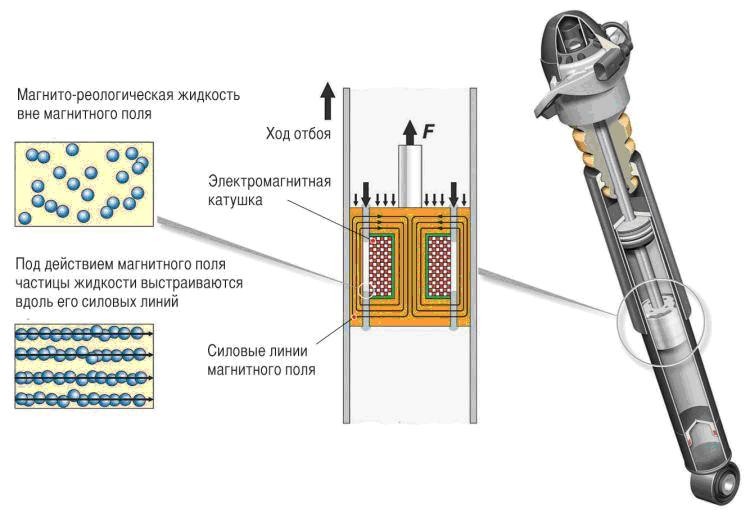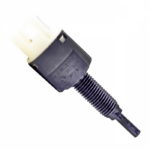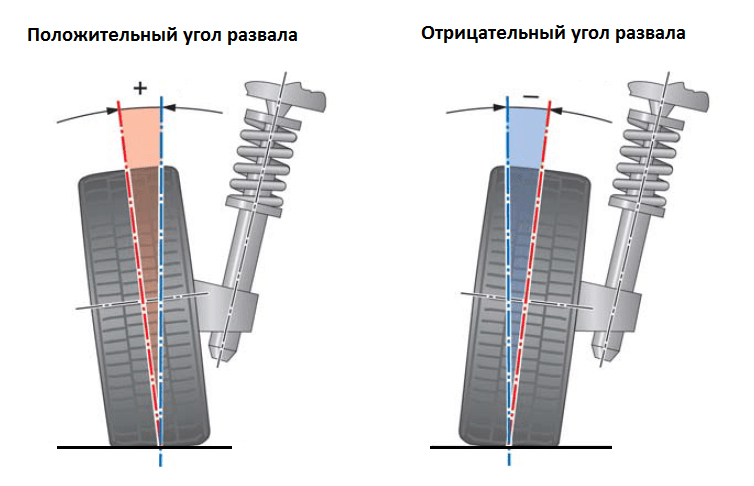
Purpose and types of car wheel alignment angles
Content
In order to ensure efficient and safe operation, the manufacturer has calculated wheel alignment angles for each vehicle.
The geometry of the suspension and wheels is specified and verified during sea trials.

Assignment of wheel alignment angles
The spatial position of the wheels specified by the manufacturer provides:
- Adequate response of the wheels and suspension to the forces and loads that occur in all driving modes.
- Good and predictable controllability of the machine, safe performance of complex and high-speed maneuvers.
- Low running resistance, even tread wear.
- High fuel efficiency, lower operating costs.
Types of basic installation angles
| Name | Car axis | Adjustability | What depends on the parameter |
| Camber angle | lobby | Yes, except for continuous drive axles and dependent suspensions. | Cornering stability and even tread wear |
| Rear | Yes, in multi-link devices. | ||
| Toe angle | lobby | Yes, in all designs. | The straightness of the trajectory, the uniformity of tire wear. |
| Rear | Adjustable only in multi-link thrusters | ||
| Lateral angle of inclination of the axis of rotation | lobby | No adjustment provided. | Lateral stability in turns. |
| Longitudinal angle of inclination of the axis of rotation | lobby | Depending on the design. | Facilitates corner exit, maintains straightness |
| Breaking shoulder | lobby | Not regulated. | Maintains direction during steady travel and braking. |
Camber
The angle between the median plane of the wheel and the vertical plane. Can be neutral, positive and negative.
- Positive camber - the middle plane of the wheel deviates outward.
- Negative - the wheel is tilted towards the body.
The camber must be symmetrical, the angles of the wheels of one axle must be the same, otherwise the car will pull in the direction of greater camber.

It is created by the position of the semi-axle trunnion and the hub, in independent lever suspensions it is regulated by the position of the transverse levers. In MacPherson-type structures, camber is determined by the relative position of the lower arm and shock absorber strut.
In obsolete pivot-type suspensions and in solid axles of classic SUVs, camber is not adjustable and is set by the design of the steering knuckles.
Neutral (zero) camber in the chassis of passenger cars is practically never found.
Negative camber suspensions are common in the construction of sports and racing cars, for which stability in high-speed turns is important.
Deviations of the positive camber angle from the value provided by the manufacturer in any case entails negative consequences:
- An increase in camber causes the car to become unstable on bends, leads to an increase in tire friction on the road surface and rapid wear of the treads on the outside.
- Reducing the collapse leads to instability of the car, forcing the driver to constantly steer. Reduces rolling resistance, but leads to increased wear on the inside of the tires.
Convergence
The angle between the longitudinal axis of the machine and the plane of rotation of the wheel.
The planes of rotation of the wheels converge towards each other and intersect in front of the car - the convergence is positive.

In the operational documentation, the convergence value can be indicated in angular degrees or in millimeters. In this case, the toe-in is defined as the difference in the distances between the disc rims at the extreme front and rear points at the height of the axis of rotation, and is calculated as an average value based on the results of two or three measurements when the machine is rolling on a flat surface. Before carrying out measurements, it is necessary to make sure that there is no lateral runout of the discs.
On bends, the front wheels move along curves of different radii, so it is extremely important that their individual convergences are equal and the sum does not exceed the values and tolerances set by the manufacturer.
Regardless of the type of suspension, the steered wheels of passenger cars have positive toe-in and are symmetrically turned inward with respect to the “forward” direction of travel.
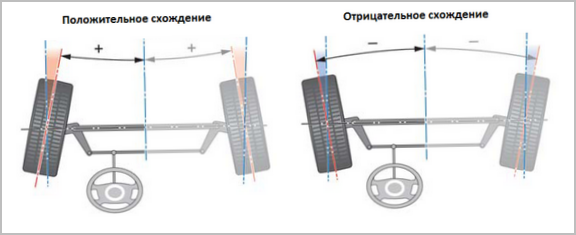
Negative toe-in of one or both wheels is not allowed.
Deviations of convergence from the set value make it difficult to control the car and keep it on the trajectory during high-speed maneuvers. Besides:
- Reducing toe-in reduces rolling resistance, but worsens traction.
- Increased convergence leads to increased lateral friction and accelerated uneven wear of the treads.
Lateral angle of inclination of the axis of rotation
The angle between the vertical plane and the axis of rotation of the wheel.
The axis of rotation of the steered wheels must be directed inside the machine. When turning, the outer wheel tends to raise the body, while the inner wheel tends to lower it. As a result, forces are generated in the suspension that counteract body roll and facilitate the return of the suspension units to the neutral position.
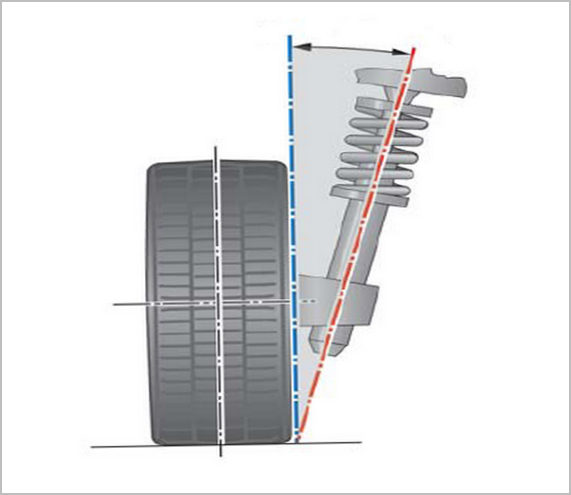
The transverse inclination of the steering axes is fixed by attaching the steering knuckle to the suspension elements and can only change after an extreme impact, for example, when skidding with a side impact on a curb.
The difference in the angles of the transverse inclination of the axles causes the car to constantly move away from the straight path, forcing the driver to continuously and intensely steer.
Caster angle of rotation axis
It is located in the longitudinal plane and is formed by a vertical straight line and a straight line passing through the centers of rotation of the wheel.
The line of turning centers in a link suspension passes through the ball bearings of the levers, in MacPherson type structures through the upper and lower attachment points of the shock absorber strut, in a dependent beam or continuous bridge - along the axes of the pivots.

Sometimes this indicator is called "castor".
Reference. In the interface of the computer wheel alignment test stand, it is written in Russian "castor".
The parameter value can be:
- Positive, the axis of rotation of the wheel is directed relative to the vertical "back".
- Negative, the axis of rotation is directed "forward".
In passenger cars manufactured in the USSR and Russia and foreign cars sold in the Russian Federation, castor does not have a negative value.
With positive caster angles, the point of wheel contact with the ground is behind the steering axis. Lateral forces arising in motion when the wheel is turned tend to return it to its original position.
A positive castor has a positive effect on camber in corners and provides leveling and stabilizing forces. The larger the castor value, the greater these two effects.
The disadvantages of suspensions with positive castor include the large efforts required to turn the steering wheel of a stationary car.
The reason for the change in the castor may be a head-on collision of a wheel with an obstacle, a car falling into a pit or a pothole on one side, a decrease in ground clearance as a result of subsidence of worn springs.
Run-in shoulder
The distance between the plane of rotation of the steered wheel and its axis of rotation, measured on the supporting surface.
Directly affects handling and stability in motion.

Rolling shoulder - the radius along which the wheel "rolls" around the axis of rotation. It can be zero, positive (directed "out") and negative (directed "in").
Lever and dependent suspensions are designed with a positive rolling shoulder. This allows you to place a brake mechanism, hinges of levers and steering rods inside the wheel disk.
Advantages of structures with a positive rolling shoulder:
- The wheel is carried out, freeing up space in the engine compartment;
- Steering wheel effort is reduced when parking as the wheel rolls around the steering axis instead of turning in place.
The disadvantages of designs with a positive rolling shoulder: when one of the wheels hits an obstacle, the brakes on one side fail or the wheel breaks, the steering wheel is pulled out of the driver’s hands, the parts of the steering linkage are damaged, and at high speed the car goes into a skid.
To reduce the likelihood of dangerous situations, constructions of the MacPherson type, with zero or negative rolling shoulder, allow.
When selecting non-factory disks, it is necessary to take into account the parameters recommended by the manufacturer, first of all, the offset. Installing wide discs with increased reach will change the rollover shoulder, which will affect the handling and safety of the machine.
Changing installation angles and adjusting them
The position of the wheels relative to the body changes as the suspension parts wear out, and needs to be restored after replacing ball joints, silent blocks, steering rods, struts and springs.
It is recommended to combine diagnostics and adjustment of the chassis geometry with regular maintenance, without waiting for the malfunctions to “crawl out” themselves.
The convergence is set by changing the length of the steering rods. Camber - by adding and removing shims, rotating eccentrics or “breakup” bolts.
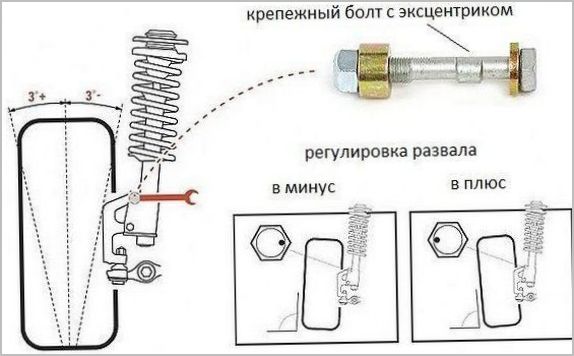
Castor adjustment is found in rare designs and comes down to removing or installing shims of various thicknesses.
To restore the parameters that were set structurally and, possibly, changed as a result of an accident or an accident, it may be necessary to completely disassemble the suspension with the measurement and troubleshooting of each unit and part and check the main reference points of the car body.
